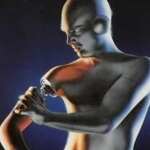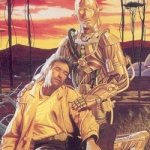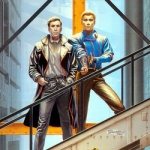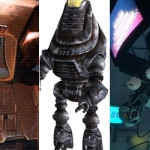
The Naked Sun is Asimov’s 1957 sequel to The Caves of Steel. After successfully concluding the case of the murdered Spacer and averting riots and strife in the overcrowded city of New York, Lije Baley has been specifically requested to aid in another murder investigation. This time, however, he must leave the city and travel to the planet Solaria, one of the outer worlds inhabited by the Spacers. Once he arrives, he finds himself partnered once again with the humanoid robot R. Daneel Olivaw, who is there not only to assist Baley but also to observe and report on the Solarians’ activities to his masters on his home world of Aurora.
While I, Robot and The Caves of Steel focused heavily on themes of prejudice and fear of those who are different, whether human or robot, The Naked Sun takes place away from earth and therefore away from these competing groups. We learn that while the humans of Earth fear robots, the Spacers, humans whose ancestors left Earth and colonized the fifty Outer Worlds, embrace the use of robots because their cultures could not have survived colonization without mechanical help. Solaria, however, is an extreme case. Its society has in fact evolved to the point that there are thousands of robots for each of the planet’s constant population of 20,000 humans who live spread out in individual estates where the robots do almost all of the work, leaving the humans free for academic and leisure pursuits.
The central focus of The Naked Sun seems to be the challenges that various characters face and the paths they take either to overcome the challenges or to stay in their comfort zones at all costs. On the one hand, we have Earthman Lije Baley, who has been forced out of the security of the enclosed, climate-controlled city and must function on a world of open air and exposure to sunlight. On the other hand, the Solarians live solitary lives, interacting with each other only by viewing each other through electronic means rather than being physically present in the same room. Only married couples ever physically “see” each other, and then at great discomfort to both parties. Physical presence is no obstacle to someone used to living in such close quarters with so many other people, and Baley must pull many strings to be able to see the people involved in the murder investigation rather than conducting his business by viewing, however sophisticated the technology. In the end, Baley is able to face his fears and begins to get used to being in the open air, but the Solarians for the most part are not able to come to terms with the cultural norms that have been taught them from an early age and accept the positive aspects of physical contact with other humans.
On the robot side of things, through Lije Baley and his interaction with Daneel Olivaw and the myriad robots of Solaria, we get an examination of the First Law (A robot may not injure a human being or, through inaction, allow a human being to come to harm) and its limitations. Until he figures out a way to escape from his robot partner, Lije finds himself prevented at almost every turn from doing some things he feels necessary to the investigation because Daneel, operating under a First Law imperative to prevent harm to the human in his care, keeps trying to protect him from the mental stress brought on by being in the open air. Additionally, despite their disgust at physical contact with other people, the Solarians must assign people to take charge of raising the children because they find that the robots are incapable of administering discipline to the children — they cannot see past the immediate harm to the child that discipline causes to the greater good for the child in the long run that results from discipline. Baley sums up both situations quite nicely when he repeatedly notes that robots are logical, but not reasonable. He also figures out a way that a person skilled at directing robots, as most Solarians are, could circumvent the First Law by giving individual instructions to several robots that would seem by themselves to be harmless, but when put together result in the poisoning of a Solarian official and several attempts on Baley’s life.
Once again, of course, Lije and Daneel (although mostly Lije) nab the murderer and save the Earth. In the process they discover that sometimes one’s strengths are really weaknesses, that there is strength in overcoming challenges, and that even though Solaria seems to be the opposite of Earth in so many ways, the two cultures are more alike than either realizes.







I LOVED all these Robot Novels and could read them forever! I admit to finding the idea of Aurora quite idyllic – all those lovely robots and FEW people, and all living in huge detached houses in beautiful countryside. At least the Aurorans had a slightly ‘healthier’ view to human contact and relationships than the Solarians.
(Daneel and Giskard can ‘care’ for me anytime!!)